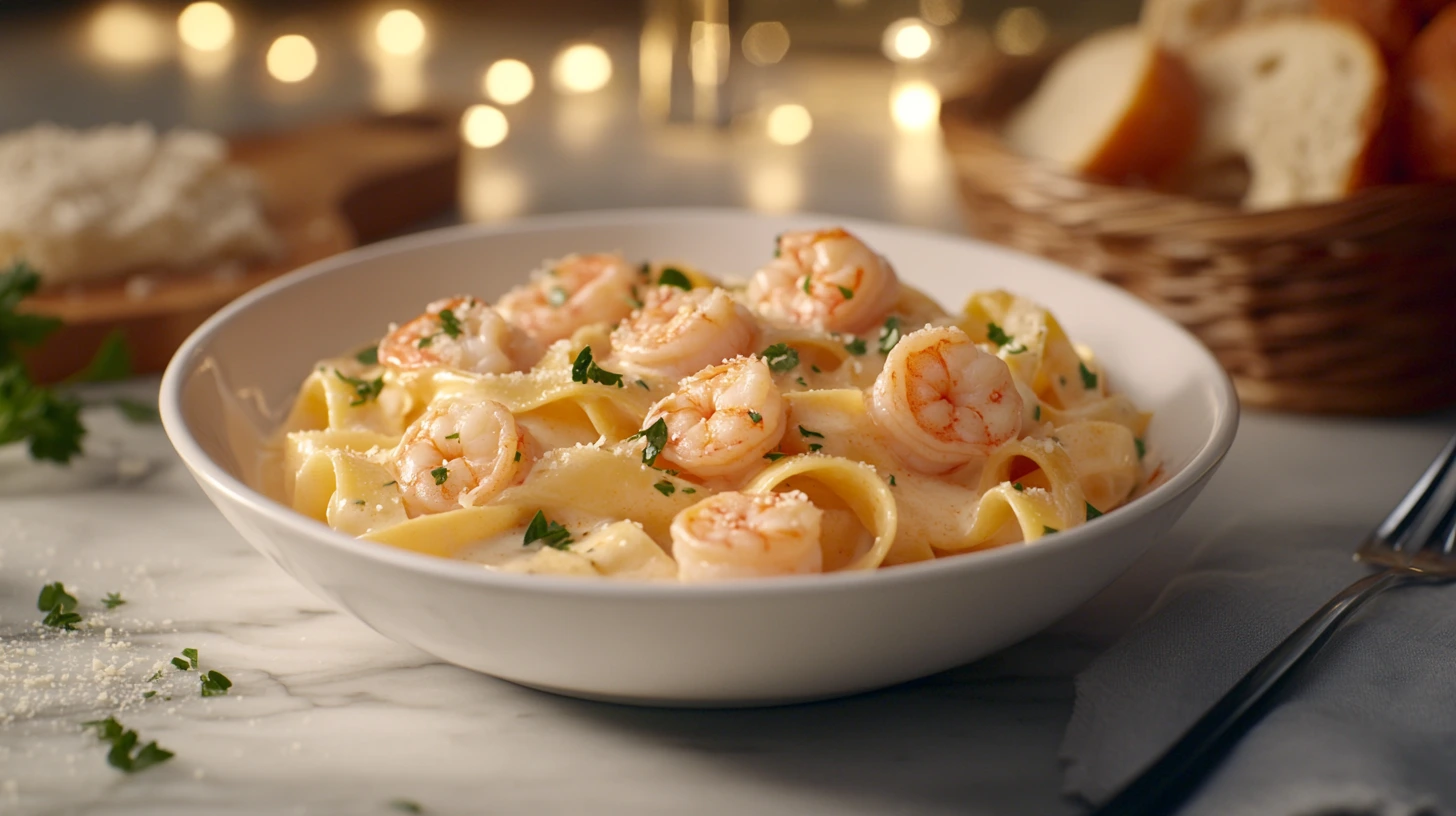Creamy shrimp pasta is a decadent and versatile dish that pleases the palate and warms the soul. This guide will take you step-by-step through every detail to perfect your recipe. From selecting the freshest shrimp to pairing the final dish with delightful sides, you’ll master the art of making creamy shrimp pasta in no time.
Introduction to Creamy Shrimp Pasta
Creamy shrimp pasta is a timeless favorite in kitchens worldwide. The combination of tender, succulent shrimp and silky, flavorful sauce makes this dish irresistible.
This recipe is popular not only for its rich taste but also for its adaptability. Whether you’re hosting a formal dinner or craving a hearty meal on a weeknight, this dish fits the bill. Plus, with the right techniques, it’s surprisingly easy to prepare.
Why You Should Try It:
- Combines rich flavors and satisfying textures.
- Easy to customize with herbs, spices, or alternative ingredients.
- Perfect for entertaining guests or enjoying solo.
Ingredients You’ll Need
Making the best creamy shrimp pasta starts with choosing quality ingredients. Here’s a breakdown of what you’ll need to recreate this indulgent recipe:
Essential Ingredients:
- Shrimp: Fresh or frozen, deveined and peeled.
- Pasta: Fettuccine, spaghetti, or penne for a sturdy base.
- Cream: Heavy cream or half-and-half for a luscious texture.
- Garlic: Minced fresh garlic to infuse the sauce.
- Butter: Unsalted for balancing richness.
- Parmesan Cheese: Finely grated for a nutty, savory kick.
- Olive Oil: For sautéing and enhancing the sauce.
Optional Add-Ins:
- Fresh parsley for garnish.
- Lemon zest for brightness.
- A pinch of red pepper flakes for heat.
With quality ingredients, your creamy shrimp pasta will shine with authentic flavors.
Selecting the Best Shrimp for Your Pasta
Choosing shrimp for your creamy shrimp pasta is a critical step. The freshness and size of the shrimp can greatly affect the final outcome of your dish.
Fresh vs. Frozen Shrimp:
- Fresh Shrimp: Ideal if available; offers better flavor and texture.
- Frozen Shrimp: A convenient and equally tasty option if thawed properly.
Tips for Shrimp Selection:
- Opt for shrimp labeled as “wild-caught” for sustainability.
- Choose medium to large shrimp for a balanced bite.
- Avoid shrimp with an overly fishy smell or slimy texture.
Properly preparing shrimp ensures a dish with clean, sweet flavors and perfect tenderness.
Choosing the Perfect Pasta Type
The pasta you select can elevate your dish by complementing the creamy sauce and shrimp.
Best Choices for Creamy Shrimp Pasta:
- Fettuccine: Wide and flat, ideal for holding creamy sauces.
- Spaghetti: A classic choice for light, silky pairings.
- Penne: Tubular pasta perfect for capturing chunks of shrimp and sauce.
Considerations:
- Use gluten-free pasta if catering to dietary needs.
- Cook pasta al dente to retain texture when combined with the sauce.
Selecting the right pasta ensures every bite is perfectly balanced.
Creating the Creamy Sauce
The sauce is the soul of any creamy shrimp pasta recipe. Its richness and flavor depth determine the dish’s overall appeal.
Steps to a Perfect Sauce:
- Start with Butter and Garlic: Melt butter and sauté minced garlic for a fragrant base.
- Add Cream: Stir in heavy cream or half-and-half for a smooth texture.
- Incorporate Parmesan: Gradually add grated cheese to thicken and flavor the sauce.
- Balance with Spices: Season with salt, pepper, and optional nutmeg.
Tips:
- Simmer the sauce on low heat to avoid separation.
- Add a splash of pasta water for a cohesive consistency.
A well-crafted sauce binds all ingredients in harmonious richness.
Cooking Techniques for Perfect Results
Mastering a few techniques ensures your creamy shrimp pasta turns out restaurant-quality.
Key Techniques:
- Sautéing Shrimp: Cook shrimp over medium heat for 2–3 minutes per side to achieve tenderness without overcooking.
- Pasta Preparation: Salt the water generously for flavorful pasta.
- Combining Ingredients: Toss pasta and shrimp in the sauce just before serving to ensure even coating.
Pro Tip:
- Avoid rinsing cooked pasta to preserve its starch, which helps the sauce cling.
These techniques result in a dish that’s perfectly cooked and well-balanced.
Step-by-Step Recipe: Creamy Shrimp Pasta
Ingredients:
- 12 oz pasta of your choice
- 1 lb shrimp, peeled and deveined
- 2 tbsp butter
- 2 tbsp olive oil
- 3 cloves garlic, minced
- 1 cup heavy cream
- ½ cup grated Parmesan cheese
- Salt and pepper to taste
Instructions:
- Cook Pasta: Boil pasta in salted water until al dente. Reserve ½ cup of pasta water, then drain.
- Sauté Shrimp: Heat butter and olive oil in a skillet. Add shrimp, season with salt and pepper, and cook until pink. Remove and set aside.
- Make Sauce: In the same skillet, sauté garlic, then pour in cream and simmer. Stir in Parmesan cheese until melted.
- Combine: Return shrimp to the skillet, add cooked pasta, and toss with sauce. Adjust consistency with reserved pasta water if needed.
- Serve: Garnish with parsley and serve warm.
This simple recipe guarantees creamy shrimp pasta that’s flavorful and satisfying.
Pairing Creamy Shrimp Pasta with Drinks and Sides
Enhance your creamy shrimp pasta with thoughtful pairings.
Best Drink Options:
- White wines like Chardonnay or Sauvignon Blanc.
- Sparkling water infused with lemon or cucumber.
Complementary Sides:
- Garlic bread or focaccia.
- A fresh green salad with vinaigrette.
- Steamed asparagus or roasted broccoli.
Pairing thoughtfully creates a complete dining experience.
Nutritional Benefits of Creamy Shrimp Pasta
Although indulgent, creamy shrimp pasta offers valuable nutrients.
Nutritional Highlights:
- Shrimp: High in protein and low in fat.
- Pasta: Provides complex carbohydrates for energy.
- Dairy: Rich in calcium and essential fats.
Tips for Healthier Variations:
- Use whole-grain pasta for added fiber.
- Substitute cream with low-fat alternatives.
Balancing ingredients ensures your creamy shrimp pasta remains nutritious and delicious.
Tips for Making Creamy Shrimp Pasta Ahead of Time
Creamy shrimp pasta is best served fresh, but you can prepare elements in advance.
Make-Ahead Tips:
- Cook and refrigerate shrimp and pasta separately.
- Prepare the sauce and store it in an airtight container.
Reheating:
- Warm leftovers gently on low heat, adding a splash of cream or milk to revive the sauce.
Proper storage ensures your creamy shrimp pasta stays fresh and flavorful.
Variations of Creamy Shrimp Pasta
Experimenting with variations adds versatility to your creamy shrimp pasta repertoire.
Popular Options:
- Cajun Shrimp Pasta: Add Cajun seasoning for a spicy kick.
- Garlic Butter Shrimp Pasta: Swap cream for a garlic butter sauce.
- Vegetarian Creamy Pasta: Replace shrimp with sautéed mushrooms.
Each variation offers a unique twist on this classic dish.
Troubleshooting Common Issues
Encountering issues while cooking? Here’s how to fix them.
Common Problems:
- Watery Sauce: Simmer longer to reduce excess liquid.
- Overcooked Shrimp: Cook shrimp until just pink and remove immediately.
- Sticky Pasta: Toss cooked pasta with olive oil before combining with sauce.
Avoiding these pitfalls ensures consistently great results.
Expert Tips for Mastering Creamy Shrimp Pasta
Use Fresh Ingredients for the Best Flavors
The foundation of any great dish lies in the quality of ingredients. When preparing creamy shrimp pasta, prioritize freshness for superior flavor and texture. Choose fresh shrimp with a firm texture and a mild, sweet aroma—avoid shrimp with any fishy or sour odors. For the sauce, use high-quality heavy cream, freshly grated Parmesan cheese, and aromatic garlic to achieve a velvety and flavorful result. Fresh herbs, such as parsley or basil, can elevate the dish with vibrant color and added complexity. Opting for fresh pasta, if available, can also enhance the overall experience by providing a richer texture.
Allow the Sauce to Rest for a Minute Before Serving
Patience is key to a perfectly creamy sauce. After preparing the sauce and tossing it with the shrimp and pasta, let it rest for a minute before serving. This resting period allows the sauce to thicken naturally as it cools slightly, creating a cohesive texture that clings to every strand of pasta. Additionally, the flavors meld together during this time, resulting in a more harmonious dish. Rushing to serve immediately might leave your sauce runny or unevenly distributed.
Always Taste and Adjust Seasonings as You Go
One of the most important skills in cooking is tasting and fine-tuning flavors throughout the process. When making creamy shrimp pasta, adjust the salt, pepper, and other seasonings incrementally to avoid over- or under-seasoning. If the sauce tastes flat, a small squeeze of lemon juice or an additional sprinkle of Parmesan can enhance its depth. For those who enjoy a kick, a dash of red pepper flakes can add the perfect amount of heat. Remember, the goal is to balance the richness of the cream with the savory elements of the dish.
Experiment and Customize the Recipe
While traditional creamy shrimp pasta recipes are fantastic, don’t hesitate to experiment. Add your favorite vegetables, such as sautéed mushrooms, spinach, or cherry tomatoes, to bring freshness and variety to the dish. Swap out heavy cream for a healthier alternative like Greek yogurt or cashew cream if dietary needs require it. Additionally, incorporating seafood like scallops or crab meat alongside shrimp can create a more decadent meal. Personalizing the recipe ensures you create a dish that perfectly suits your taste.
FAQs About Creamy Shrimp Pasta: Expert Answers
What Makes Pasta More Creamy?
To make pasta creamier, focus on creating a balanced sauce. Use heavy cream or a combination of cream and milk as the base. Adding grated Parmesan cheese helps thicken the sauce while infusing it with a nutty flavor. Incorporating pasta water, which contains starch, binds the sauce to the pasta, creating a velvety consistency. Stirring butter into the sauce just before serving also enhances its creaminess.
What Pairs Well with Shrimp Pasta?
Shrimp pasta pairs well with a variety of sides and drinks that complement its flavors. Fresh green salads with a zesty vinaigrette offer a refreshing contrast, while garlic bread or focaccia adds a satisfying crunch. Steamed vegetables like asparagus or roasted broccoli make excellent accompaniments. For drinks, consider white wines like Chardonnay or Sauvignon Blanc, or even sparkling water with a hint of citrus.
What Is Shrimp Alfredo Made Of?
Shrimp Alfredo is a classic dish made from a combination of shrimp, pasta (typically fettuccine), and a rich Alfredo sauce. The sauce is crafted using heavy cream, butter, and Parmesan cheese, often seasoned with garlic and black pepper. The shrimp is sautéed until tender and then combined with the sauce and pasta for a luxurious, creamy dish.
How Do You Thicken Seafood Pasta Sauce?
To thicken seafood pasta sauce, reduce the liquid by simmering it on low heat. Incorporate grated Parmesan cheese, which not only thickens but also enhances the flavor. Adding a small amount of cornstarch or flour mixed with cold water can also help achieve the desired consistency. For a natural method, use pasta water—the starch in the water binds the sauce for a creamy finish.
What Pairs Well with Shrimp Pasta?
Shrimp pasta pairs beautifully with sides that enhance its creamy and savory profile. A simple arugula or Caesar salad adds freshness, while crusty garlic bread provides a satisfying texture contrast. For beverages, crisp white wines or sparkling water with a twist of lemon elevate the dining experience.
Why Is Shrimp Alfredo So Popular?
Shrimp Alfredo’s popularity stems from its balance of indulgent flavors and simplicity. The creamy Alfredo sauce pairs seamlessly with tender shrimp and al dente pasta, creating a dish that feels luxurious yet approachable. Its versatility allows for customization, making it a favorite for home cooks and restaurant-goers alike.
Conclusion: Why Creamy Shrimp Pasta Is a Must-Try Recipe
Creamy shrimp pasta is more than just a meal—it’s an experience. Its rich flavors, simple preparation, and versatility make it a staple in any kitchen. Whether you’re a seasoned chef or a beginner, this dish offers endless opportunities to impress and indulge.

